🎮 北海道4,500km (Hokkaido 4,500km)
2023年 9月 19日
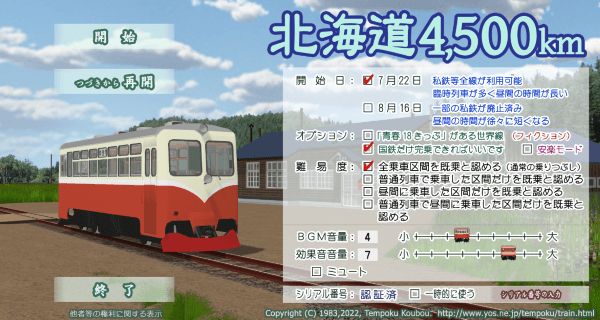
Have you ever wanted to go on holiday around Hokkaido? Do you like flipping through time table booklets and planning the most efficient yet scenic routes for your holidays? How about collecting station stamps, ticket stubs, local ekiben, and photos of all the places you visit? Does the gentle rhythm of a swaying train car make your heart sing? Have you ever wanted to spend a summer in the Japanese countryside of the 1960s? I know my audience here at Indie Tsushin, and I can practically hear you all screaming “YES” through the screen right now. In that case, you need 北海道4,500km (Hokkaido 4,500km) by Tempoku in your life right now!
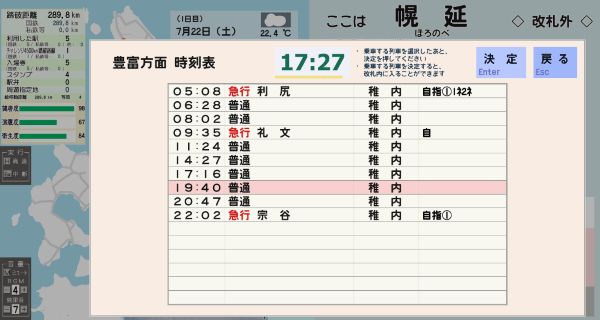
Oh no, I missed the train, now I have to wait over an hour for the next one. The real *inaka* experience!
Hokkaido 4,500km is set in Hokkaido in the summer of 1967, and your goal is to ride all 4,500 kilometers of railway lines. The game faithfully recreates the time tables and routes of that period, and there is a persistent clock in the corner that you will need to keep an eye on. You’ll need to quickly decide which lines to ride and how to make the most of your limited daylight. You will also need to keep in mind that Hokkaido of the 1960s was quite rural, so take care not to get stranded somewhere with no nearby stores or hotels.
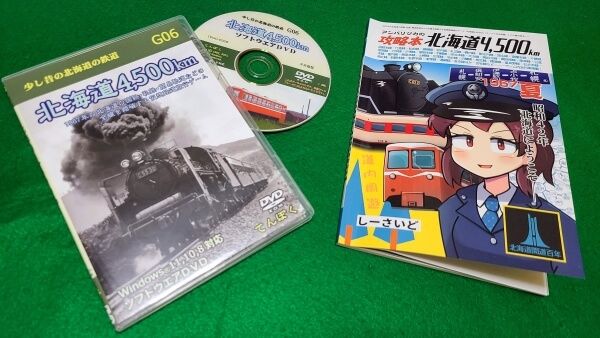
If you get the game on Booth, it comes with this neat booklet with all the time tables. Very handy!
In game and in life, if you don’t decide your trip itinerary ahead of time, you will probably run into problems. Luckily, for this game there is an accompanying booklet with time tables, a map, shopping guides, and other tips to help plan out your journey in advance. Much like the game itself, the booklet oozes charm and contains period-accurate time tables for Hokkaido’s bus and train lines.
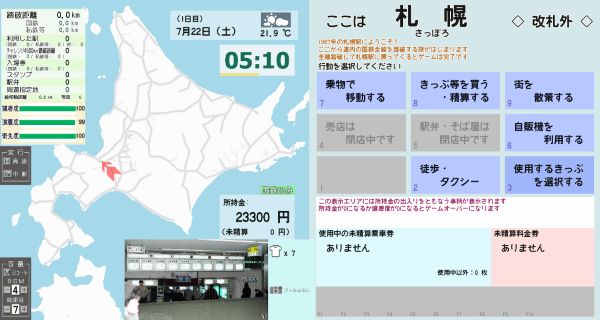
You land in Sapporo with... 23,300 yen?! Is that it?!
You start your journey in Sapporo, the capital city of Hokkaido. From there, you can buy some film for your camera and a stamp book from the shop. You will also want to buy an ekiben, or station bento, which has a decorative keepsake cover that will always remind you of the good food you ate on your trip. You will also want to visit the stationmaster for a stamp for your book, a photo of the station, and a keepsake stub for your scrapbook. After that, it is time to enter the station and pick which train to ride. Just like in real life, you will have a lot of options and not much time before the train doors shut closed! Once you have selected your train, you will automatically board when it arrives.
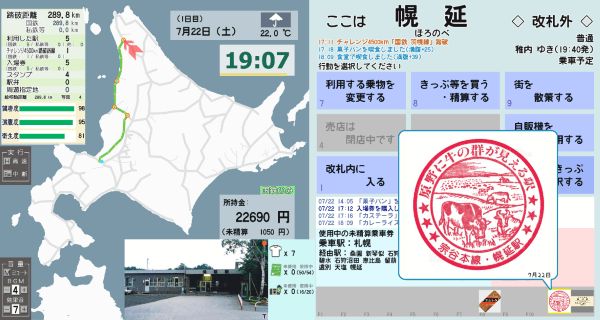
Try to collect all the station stamps, photos, and ticket stubs if you can!
While on the train, you can look out the window and see video footage of the countryside and snapshots of the stations you are passing through. You will also see where on the map you currently are in Hokkaido and all the lines you have traveled up to that point. From there, the game turns into a simple and satisfying loop of disembarking, planning the next leg of your route, and riding to your next destination via bus or train. On the way, you may want to collect more stamps, photos, ekiben, and ticket stubs to remember your journey, and to get more points at the end of the game. These objects are lovingly crafted to match their real life counterparts. The level of care and attention to detail in this game is incredible.

Just look at those prices...
If you are playing on normal mode, you will also need to keep an eye on your fatigue, hunger, and hygiene meters. At night when the trains stop running, you can choose to either sleep in the station waiting room for free, or head to town and stay at a hotel. You will also be able to wash your clothes at the coin laundromat to keep up your hygiene. And besides ekiben, you can get food from convenience stores, restaurants, and vending machines. All of these things cost money, so be careful not to overspend. After all, you still need to pay for all your train-hopping!
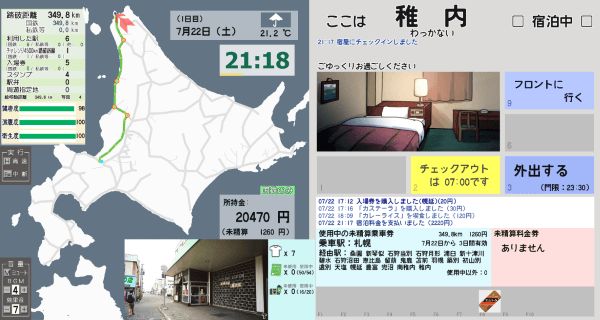
Sleeping in a hotel will cost more than roughing it, but you'll feel a lot more refreshed in the morning.
If you are playing in 安楽モード (Comfortable Mode), you won’t have to worry about these three meters. There are other options to adjust the difficulty of the game before you start, like giving yourself an all-you-can-ride pass, or only having to ride national lines to hit your goal. You can make the game as challenging or leisurely as you please.
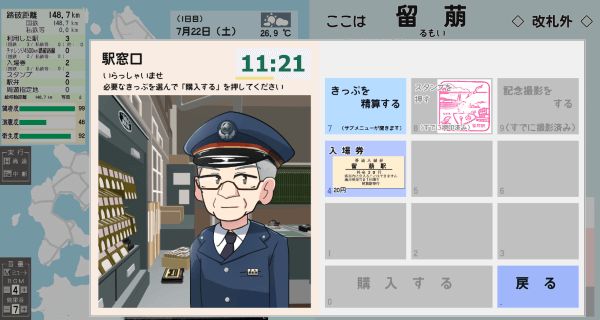
You will eventually need to stop by the stationmaster's office and pay off your outstanding fares, so be sure to budget appropriately.
When speaking with developer Tempoku about their inspiration for this game, they said that it was based on their own experiences traveling around Hokkaido. I also asked why the game was set in 1967 instead of modern times. They told me that the current railway lines in Hokkaido is just under 2,400 kilometers, but in 1967, Hokkaido had a network of 4,500 kilometers. Their goal with this game was to create a virtual experience where players could tour Hokkaido’s rail lines when they were at their peak.
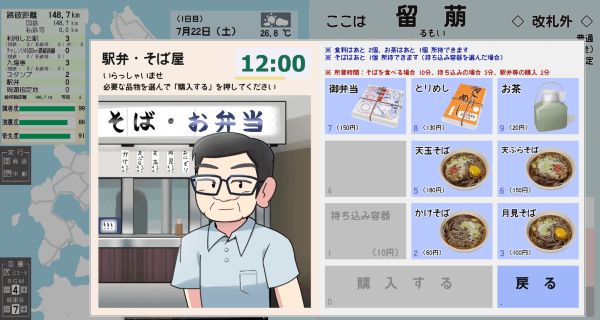
You can eat at restaurants to sate your hunger, or buy *ekiben* or snacks to take with you and eat on the train.
This is also not Tempoku’s first game about Hokkaido’s train lines. 新・北海道4,000km (New Hokkaido 4,000km) is similar to Hokkaido 4,500km, except this time set in 1983. And 札幌駅1980 (Sapporo Station 1980) is a game about managing Sapporo Station in 1980. Tempoku also has an assortment of DVDs with footage taken aboard Hokkaido’s trains. It should go without saying that Hokkaido 4,500km is the work of a deeply devoted train fan, and their love for Hokkaido’s trains is infectious!
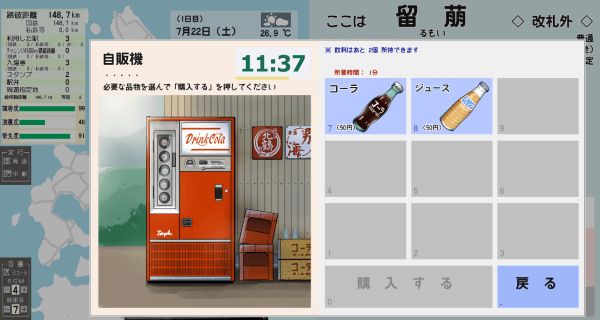
Just like in real life, you'll need to kill some time before your train arrives. How about a nice drink while you wait?
I really enjoyed my time playing Hokkaido 4,500km. My favorite way to play it is to turn down the difficulty and take in all the sights at my leisure. If you are interested in min-maxing your trip, please know that there is a thriving speedrunning community that you may want to join! Don’t you just want to cast it all away and spend your summer hopping trains across Hokkaido?
